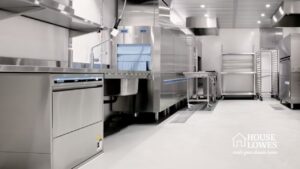The Truman White House Renovation marked a pivotal moment in American history, as the iconic presidential residence underwent a profound transformation. This renovation was not just about cosmetic improvements—it was essential to ensure the safety, functionality, and longevity of the White House. Join us as we explore the fascinating details of this historic project, a blend of necessity, innovation, and controversy.
Key Facts About the Truman Renovation
Here’s a snapshot of the most significant details about the White House renovation under Truman, highlighting its scale and impact.
| Key Details | Information |
|---|---|
| Timeline | 1948–1952 |
| President | Harry S. Truman |
| Reason for Renovation | Structural instability, outdated facilities |
| Temporary Residence | Blair House and Anderson House |
| Budget | Estimated $5.7 million (equivalent to ~$63 million today) |
| Key Changes | Complete structural overhaul, modernisation of plumbing and wiring |
| Controversies | Over budget concerns, criticism of design |
The White House Before Truman’s Renovation
By the mid-20th century, the White House was not the pristine symbol of modern governance that it is today. The residence, constructed between 1792 and 1800, had endured substantial wear and tear over the decades. The structural strain of hosting state functions, expanding staffs, and evolving technologies left it in a state of advanced deterioration.
Cracks and Sagging Floors
Structural engineers discovered deep cracks in the walls, sagging floors, and an overall lack of support for the building’s increasing weight. Astonishingly, some second-floor rooms were considered unsafe to use. It became clear that neglecting these issues endangered everyone residing or working within the iconic home.
The Need for Action
For years, smaller repairs were made to mask underlying problems. However, by 1948, it was impossible to ignore the stark reality—without intervention, the White House could collapse. President Harry Truman made the bold decision to uproot his family and take on a reconstruction task of historical magnitude.
Why Was the Renovation Necessary?
The need for the Truman renovation of the White House stemmed from decades of structural neglect, with previous administrations largely focusing on aesthetic updates rather than addressing foundational issues.
Congressional Safety Inspection
A notable moment came when Congress commissioned an inspection of the mansion’s structural condition in 1948. Experts gave a chilling verdict—sections of the White House could collapse at any moment. The decision to undertake a full-scale renovation was no longer optional.
Historical Photographs
Images taken before work began reveal shocking details—expansive cracks in walls, sagging ceilings, and crooked floors. These stark visual records left no doubt that the beloved presidential home was on the brink of disaster.
Key Changes Made During the Renovation
The harry truman White House renovation, unlike cosmetic updates of the past, sought to rebuild the property from its core. This required drastic measures, including gutting the entire interior while preserving the historic outer façade.
Structural Overhaul
- Steel Framework: A steel skeleton replaced the rotting timber frame, offering a robust foundation suited to the expanded demands of a modern presidency.
- Modern Utilities: Plumbing, electrical wiring, and air conditioning systems underwent complete modernization to meet mid-20th-century standards.
Architectural Adjustments
While preserving historical aesthetics, the renovation introduced practical design adjustments. For instance, reinforced wood flooring supported heavy furnishings, and ductwork for advanced heating was carefully concealed to maintain authenticity.
Reuse of Historical Materials
Interestingly, parts of the original timber and bricks removed during the process were repurposed elsewhere. This decision symbolised respect for the White House’s legacy even amid sweeping innovation.
Where Did Truman Live During the White House Renovation?
A major question during the renovation period was ensuring the safety and day-to-day functioning of the presidency. Where did Truman live during the White House renovation? The answer lies in Blair House, located across the street from the White House.
Life at Blair House
The temporary Presidential residence highlighted the stark contrast between the opulent White House and the more modest Blair House. Despite the simplicity, the Trumans adapted well, managing both state matters and family life with characteristic resilience.
The Role of Bess Truman and the Famous Stairs
First Lady Bess Truman took an active interest in the renovation process. One fascinating anecdote involves the iconic staircase, which was meticulously returned to its historical location after repairs. For both Bess and Harry, ensuring these small details preserved the White House’s charm and heritage.
Symbolism of Stairs
This act symbolised a broader dedication to upholding tradition while introducing functional improvements—perfectly encapsulating the ethos of the renovation project.
Criticism and Budget Concerns
While the white house renovation under Truman succeeded in preserving an architectural icon, it wasn’t without controversy.
Budget Overruns
The original budget of $5.4 million ultimately swelled to $5.7 million, sparking public criticism. Political cartoons often depicted Truman as an overspending renovator, poking at the administration’s strained resources.
Public Perception
Beyond budget controversies, some critics lamented perceived compromises in historical preservation. These debates formed a lively national discussion about balancing progress and tradition.
Materials Used and Removed
One striking feature of the renovation was the transition to modern materials. The switch to steel and concrete reduced fire hazards and improved the complex’s longevity. At the same time, intricate wooden moldings and panels from before the renovation were removed but later repurposed into commemorative items like souvenirs and furniture.
Historical Significance and Legacy
The Truman renovation of the White House expanded beyond structural improvements, etching its mark into the fabric of American history. The project set the architectural tone for future generations, ensuring the White House could adapt seamlessly to contemporary demands.
Preservation Through Change
Ultimately, this immense effort allowed the White House to remain a working symbol of democracy while adapting to the requirements of modern governance.
FAQs
Where Did Truman Stay During the White House Renovation?
During the renovation, President Truman and his family lived in Blair House, a historic government residence located close to the White House.
What Materials Were Removed During the Renovation?
Materials like rotting timber, deteriorated brick, and outdated utility systems were removed. Some wood and stone fragments were later crafted into souvenirs.
What Was the Budget for the Truman Renovation?
While the initial estimate was $5.4 million, final expenditures reached $5.7 million due to the scope of necessary work.
Why Was the Truman White House Renovation Necessary?
The residence was on the brink of collapse after decades of structural decline and strain from its expanding role in governance and state functions.
The Truman White House Renovation stands as a testament to balancing historical preservation and functional modernisation. Though challenges and controversies abounded, this monumental effort saved an American icon, ensuring its legacy for generations.
Admin Recommendation
Durable & Stylish Bronze Metal Roof – Your Complete Guide







